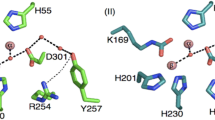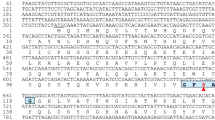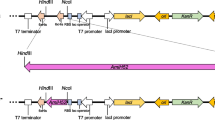Abstract
Organophosphorus pesticide (OP) hydrolases play key roles in the degradation and decontamination of agricultural and household OPs and in the detoxification of chemical warfare agents. In this study, an isofenphos-methyl hydrolase gene (imh) was cloned from the isocarbophos-degrading strain of Arthrobacter sp. scl-2 using the polymerase chain reaction method. Isofenphos-methyl hydrolase (Imh) showed 98% sequence identity with the isofenphos hydrolase from Arthrobacter sp. strain B-5. Imh was highly expressed in Escherichia coli BL21 (DE3), and the His6-tagged Imh was purified (1.7 mg/ml) with a specific activity of 14.35 U/mg for the substrate isofenphos-methyl. The molecular mass of the denatured Imh is about 44 kDa, and the isoelectric point (pI) value was estimated to be 3.4. The optimal pH and temperature for hydrolysis of isofenphos-methyl were pH 8.0 and 35 °C, respectively. The secondary structure of Imh shows that Imh is a metallo-dependent hydrolase, and it was found that Imh was completely inhibited by the metalloprotease inhibitor 1,10-phenanthroline (0.5 mM), and the catalytic activity was restored by the subsequent addition of Zn2+. Interestingly, Imh had a relatively broader substrate specificity and was capable of hydrolyzing 12 of the tested oxon and thion OPs with the P–O–Z moiety instead of the P–S(C)–Z moiety. Furthermore, it was found that the existence of an aryl or heterocyclic group in the leaving group (Z) is also important in determining the substrate specificity. Among all the substrates hydrolyzed by Imh, it was assumed that Imh preferred P–O–Z substrates still with a phosphamide bond (P–N), such as isofenphos-methyl, isofenphos, isocarbophos, and butamifos. The newly characterized Imh has a great potential for use in the decontamination and detoxification of agricultural and household OPs and is a good candidate for the study of the catalytic mechanism and substrate specificity of OP hydrolases.





Similar content being viewed by others
References
Aubert SD, Li Y, Raushel FM (2004) Mechanism for the hydrolysis of organophosphates by the bacterial phosphotriesterase. Biochem 43(19):5707–5715
Benning MM, Hong SB, Raushel FM, Holden HM (2000) The binding of substrate analogs to phosphotriesterase. J Biol Chem 275(39):30550–30560
Cheng TC, Harvey SP, Stroup AN (1993) Purification and properties of a highly active organophosphorus acid anhydrolase from Alteromonas undina. Appl Environ Microbiol 59(9):3138–3140
Cheng T, Harvey SP, Chen GL (1996) Cloning and expression of a gene encoding a bacterial enzyme for decontamination of organophosphorus nerve agents and nucleotide sequence of the enzyme. Appl Environ Microbiol 62(5):1636–1641
Chen-Goodspeed M, Sogorb MA, Wu F, Raushel FM (2001) Enhancement, relaxation, and reversal of the stereoselectivity for phosphotriesterase by rational evolution of active site residues. Biochem 40(5):1332–1339
Cisar JL, Snyder GH (2000) Mobility and persistence of pesticides applied to a US Golf Association Green—pesticides in percolate, thatch, soil, and clippings and approaches to reduce fenamiphos and fenamiphos metabolite leaching. Fate Manag Turfgrass Chem 743:106–126
Cuff JA, Clamp ME, Siddiqui AS, Finlay M, Barton GJ (1998) JPred: a consensus secondary structure prediction server. Bioinformatics 14(10):892–893
Cui Z, Li S, Fu G (2001) Isolation of methyl parathion-degrading strain M6 and cloning of the methyl parathion hydrolase gene. Appl Environ Microbiol 67(10):4922–4925
DeFrank JJ, Cheng TC (1991) Purification and properties of an organophosphorus acid anhydrase from a halophilic bacterial isolate. J Bacteriol 173(6):1938
Di Sioudi BD, Miller CE, Lai K, Grimsley JK, Wild JR (1999) Rational design of organophosphorus hydrolase for altered substrate specificities. Chem Biol Interact 119:211–223
Dumas DP, Caldwell SR, Wild JR, Raushel F (1989) Purification and properties of the phosphotriesterase from Pseudomonas diminuta. J Biol Chem 264(33):19659–19665
Fu Q, Yang R, Wang Z, She J, Li H, Liu P (2008) Field residue decline study of malathion in citrus and soil. Chinese J Pest Sci 10(4):487–490
Gopal S, Rastogi V, Ashman W, Mulbry W (2000) Mutagenesis of organophosphorus hydrolase to enhance hydrolysis of the nerve agent VX. Biochem Biophy Res Co 279(2):516–519
Gui WJ, Wang ST, Guo YR, Zhu GN (2008) Development of a one-step strip for the detection of triazophos residues in environmental samples. Anal Biochem 377(2):202–208
Hong SB, Raushel FM (1999) Stereochemical constraints on the substrate specificity of phosphotriesterase. Biochem 38(4):1159–1165
Hong Q, Zhang Z, Hong Y, Li S (2007) A microcosm study on bioremediation of fenitrothion-contaminated soil using Burkholderia sp. FDS-1. Int Biodeterior Biodegrad 59:55–61
Horne I, Sutherland TD, Harcourt RL, Russell RJ, Oakeshott JG (2002a) Identification of an opd (organophosphate degradation) gene in an Agrobacterium isolate. Appl Environ Microbiol 68(7):3371–3376
Horne I, Sutherland TD, Oakeshott JG, Russell RJ (2002b) Cloning and expression of the phosphotriesterase gene hocA from Pseudomonas monteilii C11. Microbiol 148(9):2687–2695
Horne I, Qiu X, Russell RJ, Oakeshott JG (2003) The phosphotriesterase gene opdA in Agrobacterium radiobacter P230 is transposable. FEMS Microbiol Lett 222(1):1–8
Jackson CJ, Weir K, Herlt A, Khurana J, Sutherland TD, Horne I, Easton C, Russell RJ, Scott C, Oakeshott JG (2009) Structure-based rational design of a phosphotriesterase. Appl Environ Microbiol 5153–5156
Jonsson C, Paraiba L, Mendoza M, Sabater C, Carrasco J (2001) Bioconcentration of the insecticide pyridaphenthion by the green algae Chlorella saccharophila. Chemosphere 43(3):321–325
Kumar S, Tamura K, Nei M (2004) MEGA3: integrated software for molecular evolutionary genetics analysis and sequence alignment. Brief Bioinform 5(2):150–163
Laemmli UK (1970) Cleavage of structural proteins during the assembly of the head of bacteriophage T4. Nature 227(5259):680–685
Li X, He J, Li S (2007) Isolation of a chlorpyrifos-degrading bacterium, Sphingomonas sp. strain Dsp-2, and cloning of the mpd gene. Res Microbiol 158:143–149
Li R, Guo X, Chen K, Zhu J, Li S, Jiang J (2009) Isolation of an isocarbophos-degrading strain of Arthrobacter sp. scl-2 and identification of the degradation pathway. J Microbiol Biotechnol 19(11):1439–1446
Li R, Zheng J, Wang R, Song Y, Chen Q, Yang X, Li S, Jiang J (2010) Biochemical degradation pathway of dimethoate by Paracoccus sp. Lgjj-3 isolated from treatment wastewater. Int Biodeterior Biodegrad 64:51–57
Li R, Wang R, Yang X, Chen Q, Song Y, Li S, Jiang J (2011) Biodegradation of pyridaphenthion, fenamiphos and profenofos by Arthrobacter sp. scl-2 and identification of the metabolites. China Environ Sci 31(7):1178–1185
Liu YH, Chung YC, Xiong Y (2001) Purification and characterization of a dimethoate-degrading enzyme of Aspergillus niger ZHY256, isolated from sewage. Appl Environ Microbiol 67(8):3746–3479
Liu H, Zhang JJ, Wang SJ, Zhang XE, Zhou NY (2005) Plasmid-borne catabolism of methyl parathion and p-nitrophenol in Pseudomonas sp. strain WBC-3. Biochem Biophy Res Co 334(4):1107–1114
McConnell R, Pacheco F, Wahlberg K, Klein W, Malespin O, Magnotti R, Akerblom M, Murray D (1999) Subclinical health effects of environmental pesticide contamination in a developing country: cholinesterase depression in children. Environ Res 81(2):87–91
Mulbry WW (1992) The aryldialkylphosphatase-encoding gene-Adpb from Nocardia sp. strain-B-1—cloning, sequencing and expression in Escherichia coli. Gene 121(1):149–153
Mulbry WW, Karns JS (1989) Parathion hydrolase specified by the Flavobacterium opd gene: relationship between the gene and protein. J Bacteriol 171(12):6740–6746
Munnecke DM (1976) Enzymatic hydrolysis of organophosphate insecticides, a possible pesticide disposal method. Appl Environ Microbiol 32(1):7–13
Ohshiro K, Ono T, Hoshino T, Uchiyama T (1997) Characterization of isofenphos hydrolases from Arthrobacter sp. strain B-5. J Ferment Bioeng 83(3):238–245
Ohshiro K, Kakuta T, Nikaidou N, Watanabe T, Uchiyama T (1999) Molecular cloning and nucleotide sequencing of organophosphorus insecticide hydrolase gene from Arthrobacter sp. strain B-5. J Biosci Bioeng 87(4):531–534
Omburo GA, Kuo JM, Mullins LS, Raushel F (1992) Characterization of the zinc binding site of bacterial phosphotriesterase. J Biol Chem 267(19):13278–13283
Porzio E, Merone L, Mandrich L, Rossi M, Manco G (2007) A new phosphotriesterase from Sulfolobus acidocaldarius and its comparison with the homologue from Sulfolobus solfataricus. Biochimie 89(5):625–636
Raushel FM (2002) Bacterial detoxification of organophosphate nerve agents. Curr Opin Microbiol 5(3):288–295
Sambrook J, Russell DW (2001) Molecular cloning: a laboratory manual, 3rd edn. Cold Spring Harbor Laboratory, Cold Spring Harbor
Sanchez L, Mingorance M, Pena A (2004) Chemical and physical factors affecting the extractability of methidathion from soil samples. Anal Bioanal Chem 378(3):764–769
Serdar CM, Gibson DT (1985) Enzymatic hydrolysis of organophosphates: cloning and expression of a parathion hydrolase gene from Pseudomonas diminuta. Nat Biotechnol 3:567–571
Shen Y, Lu P, Mei H, Yu H, Hong Q, Li S (2010) Isolation of a methyl parathion-degrading strain Stenotrophomonas sp. SMSP-1 and cloning of the ophc2 gene. Biodegradation 21:785–792
Singh BK (2009) Organophosphorus-degrading bacteria: ecology and industrial applications. Nat Rev Microbiol 7(2):156–164
Sogorb MA, Vilanova E (2002) Enzymes involved in the detoxification of organophosphorus, carbamate and pyrethroid insecticides through hydrolysis. Toxicol Lett 128(1–3):215–228
Tago K, Yonezawa S, Ohkouchi T, Ninomiya T, Hashimoto M, Hayatsu M (2006) A novel organophosphorus pesticide hydrolase gene encoded on a plasmid in Burkholderia sp. strain NF100. Microbes Environ 21(1):53–57
Tse H, Comba M, Alaee M (2004) Method for the determination of organophosphate insecticides in water, sediment and biota. Chemosphere 54(1):41–47
Wang L, Wen Y, Guo X, Wang G, Li S, Jiang J (2010) Degradation of methamidophos by Hyphomicrobium species MAP-1 and the biochemical degradation pathway. Biodegradation 21:513–523
Wu N, Deng M, Liang G, Chu X, Yao B, Fan Y (2004) Cloning and expression of ophc2, a new organphospho-rus hydrolase gene. Chinese Sci Bull 49(12):1245–1249
Yang C, Li R, Song Y, Chen K, Li S, Jiang J (2011) Identification of the biochemical degradation pathway of triazophos and its intermediate in Diaphorobacter sp. TPD-1. Curr Microbiol 62:1294–1301
Yu J, Zhou Z, Zhu L, Zhao Y (2008) Development of a GC-NPD standard addition method for detection of organophosphorus pesticide residues in laboratory test. Agrochemicals 9(47):657–660
Zhang R, Cui Z, Jiang J, He J, Gu X, Li S (2005) Diversity of organophosphorus pesticide-degrading bacteria in a polluted soil and conservation of their organophosphorus hydrolase genes. Can J Microbiol 51(4):337–343
Zhang J, Xu J, Liu L (2011) Rapid determination of phorate and methyl parathion residues in vegetables and fruits by gas chromatography. Sci Technol Eng 11(13):3049–3051
Acknowledgments
This work was supported by grants from the Provincial Environmental Protection Scientific Research Projects of Jiangsu Province (2009012), the Major Project on Control and Rectification of Water Body Pollution (2009ZX07103-002), and the Chinese National Natural Science Foundation (31070100).
Author information
Authors and Affiliations
Corresponding author
Rights and permissions
About this article
Cite this article
Li, R., Liu, Y., Zhang, J. et al. An isofenphos-methyl hydrolase (Imh) capable of hydrolyzing the P–O–Z moiety of organophosphorus pesticides containing an aryl or heterocyclic group. Appl Microbiol Biotechnol 94, 1553–1564 (2012). https://doi.org/10.1007/s00253-011-3709-1
Received:
Revised:
Accepted:
Published:
Issue Date:
DOI: https://doi.org/10.1007/s00253-011-3709-1




